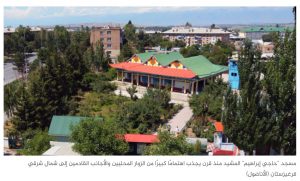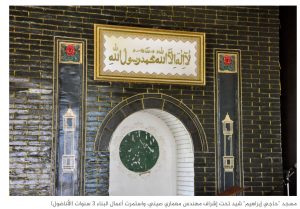The “Haji Ibrahim” mosque, built a century ago from wood without using nails, attracts a large number of local and foreign visitors to northeastern Kyrgyzstan.
The Haji Ibrahim Mosque – also known as the Dungan Mosque – was established at the beginning of the twentieth century in the city of Karagol, the largest city in the Kyrgyz province of Isik Gul.
Wooden Architecture..
The “Haji Ibrahim” mosque is the only one in Kyrgyzstan that was built of wood and still stands tall for a century, astonishing visitors with the splendor of its design and construction.
The mosque bears the finest examples of wooden architecture and has been transformed during the last century into a symbol of the city of “Qarah Gul” and an attraction for visitors because of its unique design and historical dimension.
The mosque, which was built in 1910 in the Tsarist era of Russia, according to the style of Chinese architecture, contains sculptures that embody Chinese mythical animals such as the dragon, the phoenix and the lion.
It is distinguished by its distinctive colors that reflect Chinese architecture, and the mosque – which attracts the attention of visitors with its decorations and wood carvings – occupies an important place on the map of religious tourism in Kyrgyzstan.
Built in 3 years..
The mosque was built by Haji Ibrahim, one of the leaders of the Dongan people (a Muslim ethnic group in China), who had to migrate from China to West Turkistan at the end of the nineteenth century, to escape the persecution practiced by China against Muslims.
The one-story mosque and one minaret were built in 3 years under the supervision of the Chinese architect Zhou-Su, who was invited from China with 20 other craftsmen to the city of Qara Gul by Haji Ibrahim.
Under the supervision of the Chinese architect, the mosque was built using the “bell” method, one of the methods that characterizes classical Chinese architecture, in which buildings are constructed using wood and without the use of nails.
During the construction of the mosque, spruce, elm and poplar trees were used, cut from the Tenki Tagh Mountains (in Chinese, the Tian Shan Mountains), in northern Kyrgyzstan.
The mosque can accommodate only 120 worshipers, which was allowed by the Russian tsarist administration when it was built. The stone sections of the building were completed by local builders, while the wooden part of the building was constructed by Chinese craftsmen.
The portico of the mosque was decorated with drawings of a group of fruits, most notably grapes, pears, pomegranates and peaches. The roof of the mosque was painted green, while the columns and ceiling were painted yellow and the minaret blue.
It reopened in the sixties..
During the Soviet Union era, where prayer and religious rites were banned for 25 years, the Haji Ibrahim Mosque was used as a granary, while the nearby church was used as a sports school.
And the mosque was reopened for worship in the sixties, after the struggle of the Dongan Muslims – of Chinese origin – in the years after World War II in order to restore the Islamic identity of the mosque and turn it into a place of worship.
In turn, the Turkish Cooperation and Coordination Agency “TIKA” renovated and renovated the mosque in 2016, as well as renovating the ablution room, which was welcomed by the Dungan minority, whose children immigrated to Kyrgyzstan 140 years ago.
Rustam Popukiyev, imam of the Haji Ibrahim Mosque, said that the mosque attracts attention with its special and unique architecture, which is not similar to the models of Turkish-Islamic architecture that characterize the countries of Central Asia (Turkistan).
Historic attraction..
Popukiyev explained – to the Anatolia correspondent – that the mosque was built by Haji Ibrahim, one of the leaders of the Dungan minority, and under the supervision of a Chinese architect, noting that the mosque was built using wood, and that the construction work lasted 3 years without using a single nail.
He continued: “The mosque attracts local and foreign visitors; Because of its distinctive design and historical dimension. The Haji Ibrahim Mosque occupies a privileged position in the center of the city of Karagol in northeastern Kyrgyzstan.”
Sunna Files Free Newsletter - اشترك في جريدتنا المجانية
Stay updated with our latest reports, news, designs, and more by subscribing to our newsletter! Delivered straight to your inbox twice a month, our newsletter keeps you in the loop with the most important updates from our website













